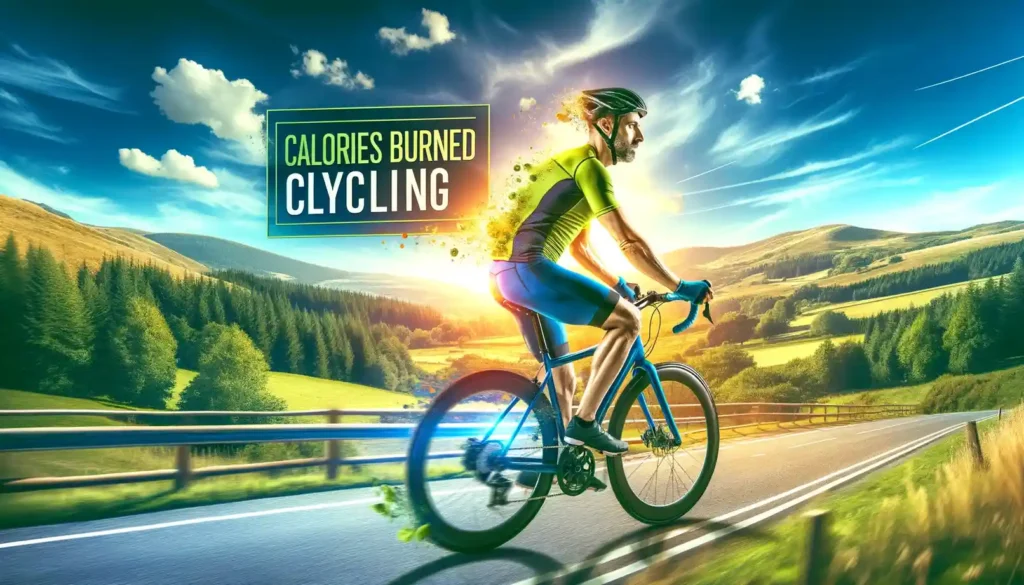
Cycling is well-known as an excellent way to burn calories and slim down. But how many calories does biking actually burn? And what tips can help you maximize calorie burn on your rides for effective weight loss? This comprehensive guide covers everything you need to know.
Defining Calories Burned Cycling
When we talk about “calories burned” cycling, we’re referring to the number of calories your body uses to fuel itself during a bike ride. This burns stored fat and carbs for energy. Tracking calories burned cycling lets you know how much of an impact your ride is making towards your health and fitness goals.
Knowing how many calories biking burns compared to other exercise is helpful too. Cycling can favorably stack up when aiming for effective weight control through increased calorie expenditure. The more calories you burn through exercise, the more likely you’ll achieve a calorie deficit for losing pounds.
Factors That Directly Impact How Many Calories Are Burned Cycling
If you’ve ever wondered why the same one hour bike ride can burn vastly different calories from day to day, it all comes down to the ride variables. The main factors that dictate calorie burn include:
Your Cycling Duration and Distance
The longer you ride and the more miles you cycle, the greater the calorie expenditure. Your body is continually burning extra fuel to move your bodyweight longer distances by bike.
The Intensity Level Maintained
Intensity or how hard you are cycling makes a major impact too. As intensity rises into higher heart rate zones, quick bursts, and heavy climbs, your body has to work much harder. This spikes calorie burn.
The Types of Terrain and Hills Covered
Hills require extra effort to climb, resulting in more calories burned per mile than flat ground. Extended climbs like on mountain bikes can be an extremely demanding cardio workout.
Total Body Weight and Cycling Speed
Heavier riders burn more calories at any intensity since more weight must be moved. Faster speeds also require more energy output, burning more calories in less time.
By tracking distance, time, speed, heart rate intensity, and elevation gain, you get an accurate picture of calories used.
Breaking Down Cycling Intensity with Calorie Burn Rates
Not every bike ride needs to be intense intervals and hill climbs. Lower and moderate intensity levels still burn substantial calories, especially for larger riders. Here’s an estimate breakdown:
Low Intensity Cycling – Calories/Hour
- 100 lbs – 290 calories
- 125 lbs – 360 calories
- 150 lbs – 430 calories
- 175 lbs – 500 calories
- 200 lbs – 570 calories
This easy pedaling pace is ideal for recovery days. You’ll burn calories just enjoying the outdoors without overdoing it.
Moderate Cycling Intensity – Calories/Hour
- 100 lbs – 400 calories
- 125 lbs – 500 calories
- 150 lbs – 600 calories
- 175 lbs – 700 calories
- 200 lbs – 800 calories
This faster but still conversational pace pushes calorie burn higher through increased effort. It’s great sustained cardio training.
Vigorous Intensity Cycling – Calories/Hour
- 100 lbs – 550 calories
- 125 lbs – 690 calories
- 150 lbs – 830 calories
- 175 lbs – 970 calories
- 200 lbs – 1110 calories
Hitting higher intensities with challenging hills, intervals, and sprints can torch 1,000+ calories per hour for heavier riders.
The Speed You Pedal Impacts Calorie Expenditure Too
Maintaining faster speeds generates greater calorie burn by demanding higher energy outputs. Here’s estimates by speed, assuming a 150 lb rider:
Pedaling at 10 mph Burns About 400 Calories Per Hour
This is a comfortable cruising pace for most cyclists to hold conversation. It generates solid fat burning over time.
Cycling at 12 mph Burns Roughly 500 Calories Per Hour
Increasing speed to 12 mph starts working cardio fitness more without excessive strain. The faster pace results in 20% higher calorie usage.
Biking at 14 mph Burns Around 600 Calories Per Hour
This quicker speed kicks up intensity noticeably, pushing respiration rates while torching calories. It’s fast enough for great calorie burn benefits.
At 16 mph and Above, Roughly 700+ Calories Per Hour are Used
Maintaining 16+ mph generates high intensity efforts perfect for calorie expenditure and improved cardiovascular endurance.
Remember heavier cyclists will burn more calories at any speed. Increasing intensity factors like hills also spikes calorie usage further.
Breaking Down the Average Cycling Calorie Burn Per Mile
Another helpful metric is calories burned per mile biked rather than hourly estimates. This varies more based on contributing factors:
The average calories burned per mile cycling for a 150 lb rider is between 15-30+ calories per mile. At a moderate effort and pace, expect around 20-25 calories used per mile. Faster speeds and very challenging terrain can push this above 30+ calories per mile.
See also: How Much Cycling to Lose Weight: Fuel Your Body Right
Tracking calories burned per mile is useful for goal setting. If aiming for 500 calories burned through cycling, you can break it down into needing to ride 20-25+ miles. Apps (Strava) and devices make tracking mileage, time, speed, elevation gain, and total calories a breeze.
Cycling Calorie Calculator for Tracking Calories Burned
To determine a close estimate on calories burned per ride, utilize an online cycling calorie calculator or integrated app feature. Input metrics like:
- Weight – Heavier riders burn more calories with more weight to move
- Time Ridden – Longer durations increase calories used through sustained effort
- Distance Cycled – More miles requires more energy output
- Speed – Faster speeds demand harder efforts burning more calories
- Elevation Gain – Total climbing directly increases calorie expenditure
More advanced calculators factor in fitness level, bike type, even wind resistance for precision.
Syncing wearable tech like heart rate straps, cycling computers, or smartwatches builds these metrics automatically for effortless tracking.
Ways to Boost Even More Calorie Burning through Your Cycling
If you really want to maximize fat burning, use these strategic tips:
Interval Training – Alternating between high intensity and easier efforts spikes overall calories burned through elevated heart rates. Push hard then recover repeatedly.
Hill Climbing – Seek routes or gradients with extended climbs challenging your legs and lungs up slopes. Hills increase calorie usage through harder efforts.
Stand Up Pedaling – Periodically standing upright engages new muscles and spikes heart rates for greater calorie expenditure. It’s also great for variation.
Afterburn Effect – Intense cycling can create an “after burn” where your body continues torching extra calories after exercise recovering from demanding efforts.
Mountain Biking vs Road Cycling – Calories Burned Comparison
Mountain biking brings additional calorie burn benefits over road cycling through:
Technical Terrain – Navigating obstacles, loose surfaces, switchbacks and climbs requires tremendous muscle engagement and fuel burning.
Downhill Coasting – Long descents provide active recovery where fewer calories are burned for a short period. Uphill efforts more than compensate.
Total mountain bike rides often burn more net calories if extended climbs are included. The tougher terrain spikes heart rates up more frequently as well.
Effective Strategies for Tracking Your Cycling Calorie Expenditure
Consistently logging calories burned cycling provides metrics to structure effective fat loss training plans. It also gives tangible proof of your hard work paying dividends towards better health.
Cycling Calorie Tracking Apps and Devices – As discussed earlier, utilize technology tools to build key cycling data points for precision calorie burn tracking.
Importance for Weight Loss Goals – When aiming to create a sustained calorie deficit through exercise for shedding pounds, tracking calories burned cycling keeps your goal front and center.
Review calorie burn rates to set mileage, speed and climb targets needed to reach projected deficits for the week or month. Celebrate hitting your goals!
Optimizing Your Rides and Training for Greater Fat Burning
Beyond just casual riding for fun, truly improving body composition requires a more complete approach:
Effective Sustained Plans – Schedule cycling workouts spanning 30-60+ minutes at challenging intensities that train cardio fitness through higher heart rates. This maximizes total calorie usage.
Balanced Exercise Routines – Complement cycling training with 2-3 days a week of strength training to build metabolism boosting lean muscle and burn additional calories through lifting.
Tightening Nutrition Habits – No exercise plan overrides a poor diet. Tighten nutrition with more protein, fiber, and vegetables while lowering processed carbs and sugary foods.
See also: Healthy Diet for Cyclists: Fueling Your Ride to Success 🍽️
The Beneficial Side Effects of Cycling Beyond Burning Calories
While effective calorie expenditure aids weight loss goals tremendously, cycling also boosts health in alternative impactful ways:
Cardiovascular Fitness – Frequent cycling provides phenomenal benefits to heart health, blood circulation, lung capacity, and arterial function – reducing disease risks.
Muscle Toning – The resistance required to continually turn pedals builds noticeable quad, glute, hamstring and calf definition – especially on hills.
Mental Health – Peacefully riding outdoors has scientifically proven effects at lowering stress hormones, boosting relaxation, and releasing feel-good endorphins.
Sample Cycling Workouts To Burn Calories Through Varied Intensities
Incorporating cycling into effective training routines requires planning workouts spanning various intensities and durations for progression:
30 Minute Low Impact Bike Ride – Riding easily in heart rate Zone 2, this shorter workout keeps calories burning through the casual cruise pace without overdoing it.
45 Minute Cross-Training Bike Ride – Push into Zone 3-4 with moderate climbs, pacing challenges and strength moves on the bike. It burns additional calories through extra challenges without being overly demanding.
60 Minute Hill Climbing Workout – Tackle long, strenuous extended climb efforts burning massive calories while building awesome cardiovascular power and leg strength in one session. Recover downhill repeating multiple times.
Fueling Your Cycling Nutrition Properly For Energy and Recovery
Hard charging bike sessions require smart nutritional strategies for keeping energy levels high while aiding muscle recovery. Core needs include:
Hydration – Drink about 7-10 oz for every 15 minutes riding. Hydration blends like sports drinks provide sugars and electrolytes lost while sweating during demanding efforts.
Protein Intake – Consuming 20-40 grams of a fast digesting protein like whey isolates after rides helps kickstart the rebuilding of taxed muscles.
See also: Can we do Cycling after Dinner?
Carb Strategies – Carb intake timing varies whether aiming for gains, maintenance or fat loss. Trial different approaches monitoring your ride energy and recovery rates closely.
Cycling Gear Investments For Further Boosting Calorie Expenditure and Tracking
Specialized cycling gear promotes improved performance capabilities. When distances, climbing totals, power output and speeds rise, your calorie burning increases.
Consider investing in:
Clipless Pedals and Shoes – Increase stroke efficiency and power transfer by securing shoes into pedals for pulling up during pedal rotations as well as pushing down.
Heart Rate Straps/Cycling Computers – Receive real time intensity and calorie burn data through wireless sensors providing helpful metrics for tracking and pacing efforts effectively.
Power Meter Pedals/Crankarms – Directly quantify work rate metrics like watts produced. This identifies strengths, weaknesses and monitors fitness gains.
Safety Tips For Enjoying Cycling and Calorie Burning For Years
While exciting cycling adventures await building fitness and burning calories, stay safe with this advice:
Obey Traffic Laws – Vehicles rule the road, so respect all signs and signals maintaining predictability. Use lights when dark and wear high visibility gear.
Equipment Checks – Ensure tires have no cracks and have pressure, chains are lubricated, brakes function, and handlebars are snug. Don’t risk mechanical failures causing accidents far from home.
Comfort Is Key – Stand frequently relieving saddle pressure to avoid numbing or pain. Proper bike fit alignment prevents overuse injuries enabling consistent riding while burning calories effectively.
Compare Major Bike Types Based on Average Calorie Burn Rates
All standard upright bicycles provide great calorie burning potential, but some notable differences in intensity do exist thanks to the riding experience each provides. Expect to burn approximately:
Mountain Bikes – More calories than other bikes per hour thanks to highly variable terrain engaging more muscles, higher average heart rates, and greater time climbing
Road/Gravel Bikes – Slightly fewer calories than mountain bikes but faster average speeds still deliver top calorie burn. Lightweight builds maximize human powered efforts.
Stationary Bikes – Usually fewer calories than riding outdoors but offer weather proof convenience and cut drafting wind resistance. Great for interval training.
No matter what bike type you pick, putting long miles using proper intensity principles guarantees results. Mix up rides across different bikes minimizing overuse injuries while keeping motivation high.
Cycling Effectively For Weight Loss and Calorie Deficits
Creating consistent calorie deficits through cycling and other activity is the ultimate key for dropping pounds. Here’s what to expect:
Calorie Deficits – Target burning 500 or more calories per cycling workout to make major dents racing towards weekly deficits between 1500-3500 calories for shedding 1-2 lbs weekly at a safe pace.
Strength Training’s Role – Don’t neglect resistance training which builds fat burning muscle and spikes daily resting metabolic rates essential for long term weight maintenance after slimming down initially.
Make calorie tracking a daily habit and celebrate hitting mini milestones along the way like consecutive workout days, weekly mileage bests or slimmer waistlines from hard work paying off!
Frequently Asked Questions on Calories Burned Cycling
How many calories does bicycle riding burn?
Calories burned cycling varies tremendously based on the duration and intensity of rides. Expect rates between 400 to over 1000+ calories per hour. Tracking metrics like speed, distance, hills and effort levels accurately calculates calories used.
Is cycling or running better for weight loss?
Cycling and running can both effectively aid weight loss efforts through calorie deficits. Running often burns more calories per hour but the impact may hinder frequent training. Cycling is lower impact enabling more miles and total calorie burn long term.
Does bicycle riding burn belly fat?
Belly fat cannot be spot reduced through direct exercise targeting the midsection. However, consistent cycling leading to daily calorie deficits will reduce overall body fat percentages including belly fat levels over time. Additional core and strength training speeds results.
Is cycling enough to lose weight?
Frequent, sustained and intense cycling leading to high calorie burn rates creates deficits promoting safe weight loss when combined with a quality nutrition plan. Long term fitness upkeep requires mixing cycling mileage with 2-3 days a week of strength training as well.
How fast should I cycle to lose weight?
Instead of chasing speed, focus more on sustaining challenging heart rate zones for 30-90+ minutes that feel moderately difficult. This maximizes calories burned. Completing higher weekly mileage totals is the ultimate goal. Speed may naturally increase as your fitness level improves.
Conclusion – Start Cycling Now to Maximize Calorie Burning for Better Health
The verdict is clear – saddle up and start pedaling away the miles to accelerate your calorie burning and fat loss. Cycling is an extremely time efficient way to generate high calorie expenditure in a low impact, equipment friendly, and accessible activity. Track your mileage, heart rates, and caloric usage then bask in your ever growing fitness.
Consistency and progressively bumping duration, frequency, total weekly miles and climbing challenges facilitates sky high calorie burn rates synergizing






